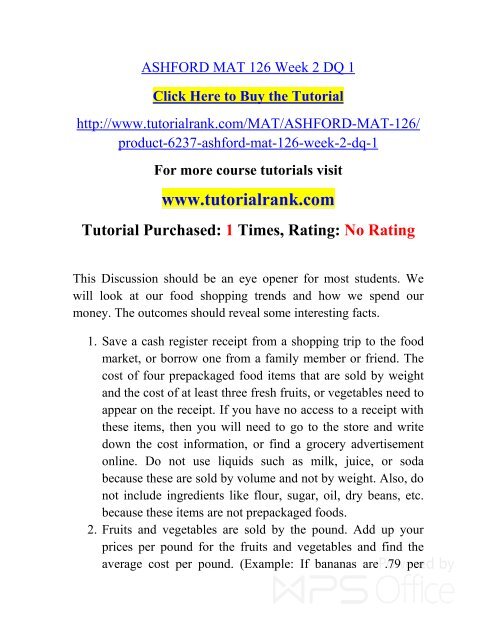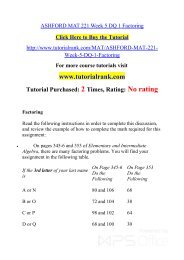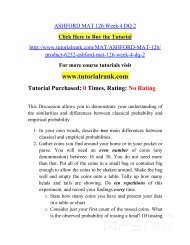MAT 126 ASH Courses /TutorialRank
For more course tutorials visit www.tutorialrank.com Tutorial Purchased: 1 Times, Rating: No Rating This Discussion should be an eye opener for most students. We will look at our food shopping trends and how we spend our money. The outcomes should reveal some interesting facts. 1. Save a cash register receipt from a shopping trip to the food market, or borrow one from a family member or friend. The cost of four prepackaged food items that are sold by weight and the cost of at least three fresh fruits, or vegetables need to appear on the receipt. If you have no access to a receipt with these items, then you will need to go to the store and write down the cost information, or find a grocery advertisement online. Do not use liquids such as milk, juice, or soda because these are sold by volume and not by weight. Also, do not include ingredients like flour, sugar, oil, dry beans, etc. because these items are not prepackaged foods. 2. Fruits and vegetables are sold by the pound. Add up your prices per pound for the fruits and vegetables and find the average cost per pound. (Example: If bananas are .79 per pound and apples are .59 per pound, the average is calculated like this: (.79 + .59)/2 = 1.38/2 = .69 per pound on average for the two fruits.) 3. Locate the weight of your prepackaged food items. (For example, on a box of Frosted Flakes it says 15 oz.) 4. Add up all of the weights for your prepackaged items in ounces, and then add up all of the costs for your four prepackaged items. 5. From the totals, find the average cost per ounce of prepackaged items. Convert your results to cost per pound. (Hint: How many ounces in a pound?) 6. Now, compare the cost per pound of unprocessed food compared to prepackaged processed food. Discuss your comparison. Are you amazed or did you expect these results? 7. Respond to at least two of your classmates’ postings. Do the calculations seem reasonable? Based on the posting you authored and the postings you read, do we seem to be paying
For more course tutorials visit
www.tutorialrank.com
Tutorial Purchased: 1 Times, Rating: No Rating
This Discussion should be an eye opener for most students. We will look at our food shopping trends and how we spend our money. The outcomes should reveal some interesting facts.
1. Save a cash register receipt from a shopping trip to the food market, or borrow one from a family member or friend. The cost of four prepackaged food items that are sold by weight and the cost of at least three fresh fruits, or vegetables need to appear on the receipt. If you have no access to a receipt with these items, then you will need to go to the store and write down the cost information, or find a grocery advertisement online. Do not use liquids such as milk, juice, or soda because these are sold by volume and not by weight. Also, do not include ingredients like flour, sugar, oil, dry beans, etc. because these items are not prepackaged foods.
2. Fruits and vegetables are sold by the pound. Add up your prices per pound for the fruits and vegetables and find the average cost per pound. (Example: If bananas are .79 per pound and apples are .59 per pound, the average is calculated like this: (.79 + .59)/2 = 1.38/2 = .69 per pound on average for the two fruits.)
3. Locate the weight of your prepackaged food items. (For example, on a box of Frosted Flakes it says 15 oz.)
4. Add up all of the weights for your prepackaged items in ounces, and then add up all of the costs for your four prepackaged items.
5. From the totals, find the average cost per ounce of prepackaged items. Convert your results to cost per pound. (Hint: How many ounces in a pound?)
6. Now, compare the cost per pound of unprocessed food compared to prepackaged processed food. Discuss your comparison. Are you amazed or did you expect these results?
7. Respond to at least two of your classmates’ postings. Do the calculations seem reasonable? Based on the posting you authored and the postings you read, do we seem to be paying
Create successful ePaper yourself
Turn your PDF publications into a flip-book with our unique Google optimized e-Paper software.
<strong>ASH</strong>FORD <strong>MAT</strong> <strong>126</strong> Week 2 DQ 1<br />
Click Here to Buy the Tutorial<br />
http://www.tutorialrank.com/<strong>MAT</strong>/<strong>ASH</strong>FORD-<strong>MAT</strong>-<strong>126</strong>/<br />
product-6237-ashford-mat-<strong>126</strong>-week-2-dq-1<br />
For more course tutorials visit<br />
www.tutorialrank.com<br />
Tutorial Purchased: 1 Times, Rating: No Rating<br />
This Discussion should be an eye opener for most students. We<br />
will look at our food shopping trends and how we spend our<br />
money. The outcomes should reveal some interesting facts.<br />
1. Save a cash register receipt from a shopping trip to the food<br />
market, or borrow one from a family member or friend. The<br />
cost of four prepackaged food items that are sold by weight<br />
and the cost of at least three fresh fruits, or vegetables need to<br />
appear on the receipt. If you have no access to a receipt with<br />
these items, then you will need to go to the store and write<br />
down the cost information, or find a grocery advertisement<br />
online. Do not use liquids such as milk, juice, or soda<br />
because these are sold by volume and not by weight. Also, do<br />
not include ingredients like flour, sugar, oil, dry beans, etc.<br />
because these items are not prepackaged foods.<br />
2. Fruits and vegetables are sold by the pound. Add up your<br />
prices per pound for the fruits and vegetables and find the<br />
average cost per pound. (Example: If bananas are .79 per
pound and apples are .59 per pound, the average is calculated<br />
like this: (.79 + .59)/2 = 1.38/2 = .69 per pound on average<br />
for the two fruits.)<br />
3. Locate the weight of your prepackaged food items. (For<br />
example, on a box of Frosted Flakes it says 15 oz.)<br />
4. Add up all of the weights for your prepackaged items in<br />
ounces, and then add up all of the costs for your four<br />
prepackaged items.<br />
5. From the totals, find the average cost per ounce of<br />
prepackaged items. Convert your results to cost per pound.<br />
(Hint: How many ounces in a pound?)<br />
6. Now, compare the cost per pound of unprocessed food<br />
compared to prepackaged processed food. Discuss your<br />
comparison. Are you amazed or did you expect these<br />
results?<br />
7. Respond to at least two of your classmates’ postings. Do the<br />
calculations seem reasonable? Based on the posting you<br />
authored and the postings you read, do we seem to be paying<br />
for the product, convenience or the packaging?

















